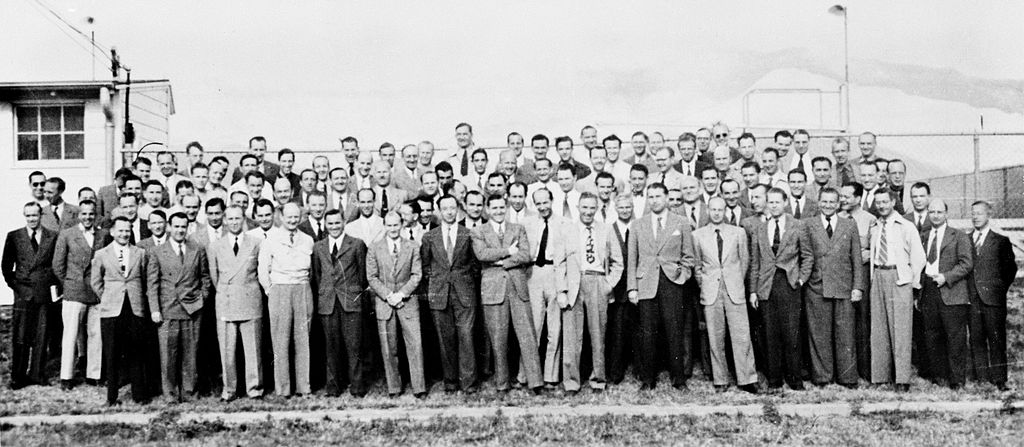 |
| Operation Paperclip |
Between 1945 and 1955, more than 1,600 German and Austrian technicians and scientists were brought to the United States through a project codenamed Operation Paperclip and a series of sister programs.
Despite the fact that many of those scientists—among them Wernher von Braun, the father of the U.S. rocket program—were rumored to be Nazi war criminals, U.S. government and military officials allegedly concealed information about many of them in a major cover-up effort aimed at facilitating their legal entry into the United States. U.S. officers identified the chosen German scientists by attaching a paperclip to their personal file.
Even before the end of World War II, U.S. scientists and military personnel had begun the search for German scientists under Operation Paperclip’s predecessor, Project Overcast. They felt the need for German expertise because outstanding German design and technology had often offset Allied advantages of manpower during the war.
  |
Therefore, they were particularly interested in locating experts in rocketry, aircraft design, and aviation medicine, to use their capabilities to shorten the war against Japan. Hundreds of Germans were taken to interrogation centers, among them many of the scientists who had been engaged in developing the V2 rocket at the Peenemünde missile base on the Baltic Sea under Wernher von Braun.
Other prominent German scientists included von Braun’s close associate, General Walter Dornberger; the latter’s wartime chief of staff, Herbert Axter; the deputy technical director, Arthur Rudolph; and an aviation doctor, Hubertus Strughold.
The group included other scientists not involved in rocketry, such as infectious diseases expert Walter Schreiber, desalinization specialist Konrad Schaefer, and Kurt Blome, who was engaged in biological warfare research.
U.S. government agencies decided that the United States should secure their services permanently and allow them to immigrate. The reasons for the apparent willingness of government and army officials to overlook and actively conceal information about German scientists’ active involvement in war crimes were manifold.
In addition to exploiting German technical know-how, the process assured that Germany could not use its scientists and their knowledge to rebuild its forces. Finally, an intense competition for German technical expertise, not only with the Soviet Union, but also with France and Great Britain, triggered a policy of denial born out of the fear that America’s competitors could tip the strategic balance in their favor.
Therefore, the State-War-Navy Coordinating Committee formulated the policy paper SWNCC 257/5, which allowed the admittance of specialists from Germany in the national interest. This required a special policy as U.S. immigration law forbade the entry of members of fascist organizations. Official Paperclip policy prohibited the utilization of war criminals or active Nazis, but did not explicitly rule out nominal party members.
According to Linda Hunt, a former CNN investigative reporter, who was the first researcher to have access to formerly closed material, the first background checks of possible candidates for Project Paperclip by the Joint Intelligence Objectives Agency (JIOA)—the agency under the Joint Chiefs of Staff responsible for the implementation of the operation—revealed that many had participated in brutalized slave labor and experiments on humans, and had committed other crimes.
Therefore, State Department officials, especially the liaison to the JIOA, Samuel Klaus, refused to accept many of the applicants, believing that Nazi war criminals constituted a threat to U.S. security.
In reaction to this deadlock between the State Department and the JIOA, the latter apparently advised the army to withhold or change incriminating dossiers about German scientists. The report on Wernher von Braun from September 1948, for example, described him as a potential security threat. Five months later the army had upgraded his classification to the role of a mere opportunist.
The expertise the Germans brought with them played a vital role in the U.S. space program, in particular in the development of the Saturn rockets and the astronauts’ preparation for high-altitude flying. For decades, government agencies and the public were not concerned that alleged Nazi war criminals lived in the United States and were employed in government programs and private corporations.
The mid-1970s saw the first legislative investigations into the matter, partly due to a growing awareness that the last survivors of the Holocaust and slave labor would die soon. A subcommittee of the House Judiciary Committee under the leadership of Joshua Eilberg (D-PA) held hearings in 1977 and 1978.
Its members concluded that government agencies had been more concerned about Communist propaganda than bringing these criminals to justice. Partly as a result of these deliberations, the Office of Special Investigations (OSI) was founded in 1979, with the goal to locate and try Nazi war criminals living in the United States.
It renewed its efforts after the opening of Russian archives to U.S. OSI researchers in the early 1990s, but due to the death of most suspects their investigations are destined to be short lived. As most Germans who participated in Operation Paperclip entered the United States legally, none of them have been prosecuted.